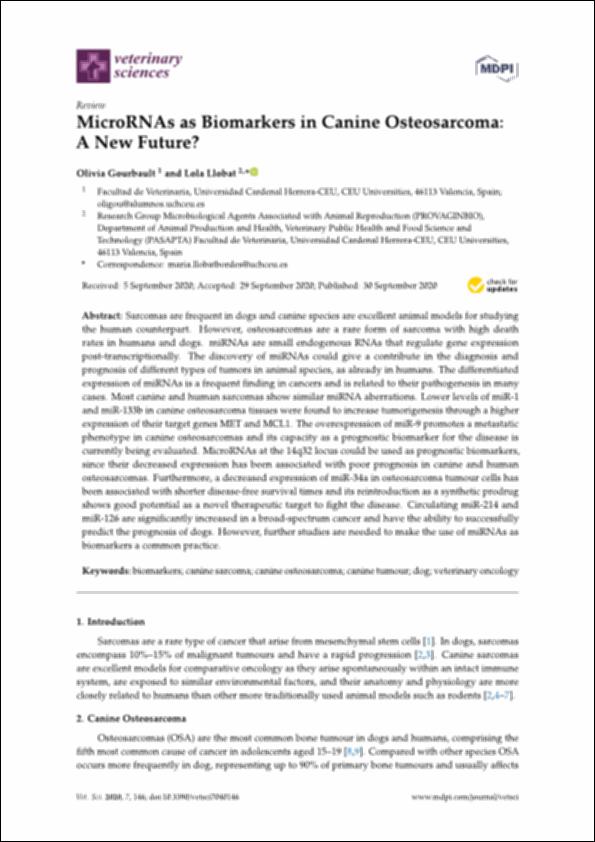Por favor, use este identificador para citar o enlazar este ítem:
http://hdl.handle.net/10637/12430MicroRNAs as biomarkers in canine osteosarcoma : a new future?
| Título : | MicroRNAs as biomarkers in canine osteosarcoma : a new future? |
| Autor : | Gourbault, Olivia Llobat Bordes, Lola |
| Materias: | Oncología veterinaria.; Veterinary oncology.; Tumores en los perros.; Tumor markers.; Osteosarcoma.; Marcadores tumorales.; Tumors in dogs. |
| Editorial : | MDPI |
| Citación : | Gourbault, O. & Llobat, L. (2020). MicroRNAs as Biomarkers in Canine Osteosarcoma: A New Future?. Veterinary Sciences, vol. 7, i. 4 (30 sep. 2020), art. 146. DOI: http://dx.doi.org/10.3390/vetsci7040146 |
| Resumen : | Sarcomas are frequent in dogs and canine species are excellent animal models for studying the human counterpart. However, osteosarcomas are a rare form of sarcoma with high death rates in humans and dogs. miRNAs are small endogenous RNAs that regulate gene expression post-transcriptionally. The discovery of miRNAs could give a contribute in the diagnosis and prognosis of di erent types of tumors in animal species, as already in humans. The di erentiated expression of miRNAs is a frequent finding in cancers and is related to their pathogenesis in many cases. Most canine and human sarcomas show similar miRNA aberrations. Lower levels of miR-1 and miR-133b in canine osteosarcoma tissues were found to increase tumorigenesis through a higher expression of their target genes MET and MCL1. The overexpression of miR-9 promotes a metastatic phenotype in canine osteosarcomas and its capacity as a prognostic biomarker for the disease is currently being evaluated. MicroRNAs at the 14q32 locus could be used as prognostic biomarkers, since their decreased expression has been associated with poor prognosis in canine and human osteosarcomas. Furthermore, a decreased expression of miR-34a in osteosarcoma tumour cells has been associated with shorter disease-free survival times and its reintroduction as a synthetic prodrug shows good potential as a novel therapeutic target to fight the disease. Circulating miR-214 and miR-126 are significantly increased in a broad-spectrum cancer and have the ability to successfully predict the prognosis of dogs. However, further studies are needed to make the use of miRNAs as biomarkers a common practice. |
| Descripción : | En Veterinary Sciences. Basilea (Suiza) : MDPI. Vol. 7, n. 4 (30 sep. 2020), art. 146. e-ISSN 2306-7381. Este artículo se encuentra disponible en la siguiente URL: https://www.mdpi.com/2306-7381/7/4/146 |
| URI : | http://hdl.handle.net/10637/12430 |
| Derechos: | http://creativecommons.org/licenses/by/4.0/deed.es |
| ISSN : | 2306-7381 (Electrónico). |
| Fecha de publicación : | 30-sep-2020 |
| Centro : | Universidad Cardenal Herrera-CEU |
| Aparece en las colecciones: | Dpto. Producción y Sanidad Animal, Salud Pública Veterinaria y Ciencia y Tecnología de los Alimentos |
Los ítems de DSpace están protegidos por copyright, con todos los derechos reservados, a menos que se indique lo contrario.


